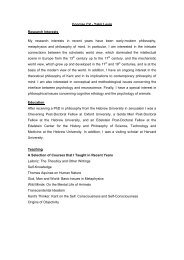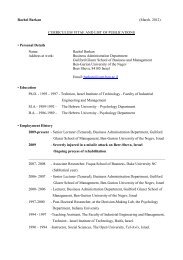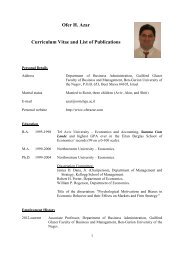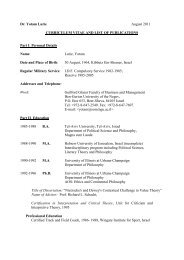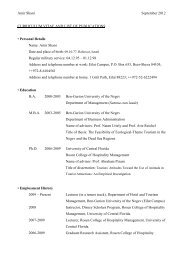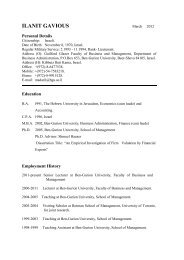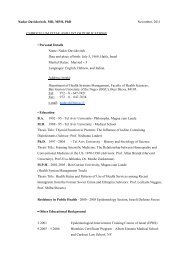cover 2006
cover 2006
cover 2006
You also want an ePaper? Increase the reach of your titles
YUMPU automatically turns print PDFs into web optimized ePapers that Google loves.
overconsumption of saturated fatty<br />
acids, which are consumed<br />
extensively in a Western diet, causes<br />
intracellular accumulation of fat in<br />
exocrine pancreas tissue and is<br />
associated with cellular dysfunction<br />
and cell death, ultimately<br />
contributing to the pathogenesis of<br />
pancreatic diseases.<br />
Another aspect of Birk’s research<br />
deals with the biological signals that<br />
control satiety and hunger and the<br />
mechanisms through which they<br />
regulate the synthesis and secretion<br />
of digestive enzymes by the exocrine<br />
pancreas. She proved that some of<br />
the signals that regulate satiety and<br />
hunger also regulate the release or<br />
inhibition of digestive enzymes.<br />
Modifications of these signals<br />
might serve as pharmaceutical<br />
compounds that reduce digestion<br />
and absorption of dietary fats.<br />
Birk is also researching fat storage.<br />
Overflow of fat into the body is<br />
directed to storage at the most<br />
efficient fat storage place – the fat<br />
cell or adipocyte. Until some ten<br />
years ago, it was thought that<br />
adipose tissue was physiologically<br />
inactive, designed mainly for<br />
storage. Following the dis<strong>cover</strong>y<br />
that it secretes many proteins that<br />
signal the brain regarding the<br />
amount of fat stored in adipose<br />
tissue, the view has changed.<br />
“This has opened a new world of<br />
research on adipose tissue, not only<br />
as a storage place, but as a<br />
metabolically active tissue that plays<br />
a critical role in the regulation of<br />
satiety and hunger,” notes Birk.<br />
Adipose tissue develops from<br />
“innocent” pre-adipocytes into fully<br />
differentiated storage cells that have<br />
the metabolic capability of efficiently<br />
storing fat. In this process, several<br />
genes are “turned on” one after the<br />
other in a known sequence. Birk’s<br />
lab is studying a set of new genes<br />
that play an important role in this<br />
process. “We still need to learn the<br />
complete sequence of genes<br />
involved, which will enable us to<br />
manipulate the formation or lack of<br />
formation of adipose tissue. We also<br />
study how this sequence is regulated<br />
by specific fats and specific<br />
metabolic states, such as diabetes<br />
and obesity” says Birk.“ On one<br />
hand, fatty acids act in enhancing<br />
the formation of fully differentiated<br />
fat-storing adipose cells. On the<br />
other hand, some of these fatty acids<br />
inhibit their formation.” Special fatty<br />
acids also show promising results<br />
when they are incorporated into<br />
diets designed for people who want<br />
to lose or gain weight. This research<br />
is of interest not only in terms of<br />
basic science; it is also a first step in<br />
finding new strategies that could<br />
facilitate or inhibit development of<br />
adipose tissue.<br />
With regard to Birk herself, does<br />
she follow a strict dietary regime?<br />
“I eat a balanced diet. I am not a<br />
fanatic – we should never forget the<br />
quality of life aspect,” she answers.<br />
“We should always, though, be<br />
aware of what we put in our<br />
bodies.”<br />
BGU NOW 43



